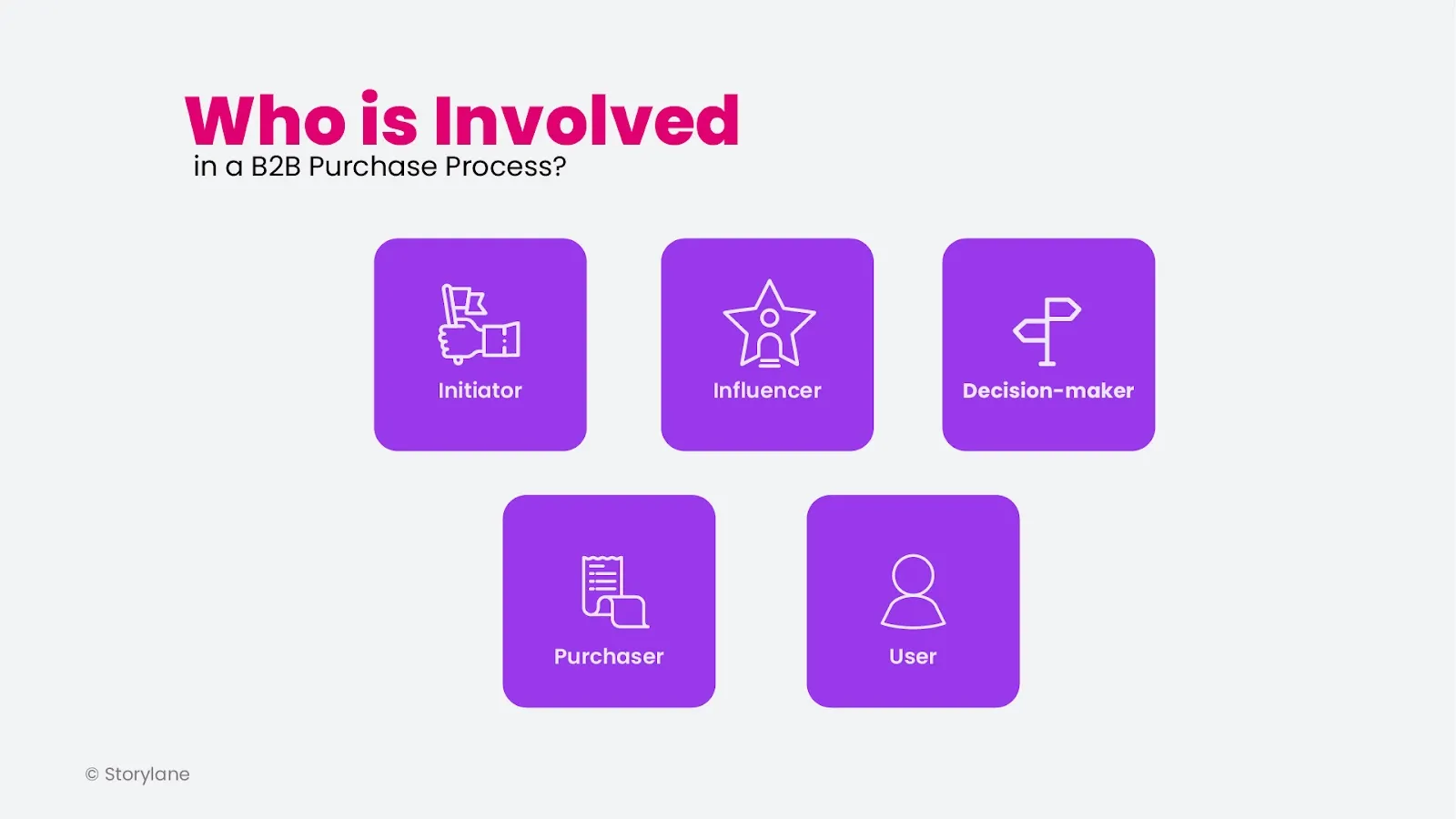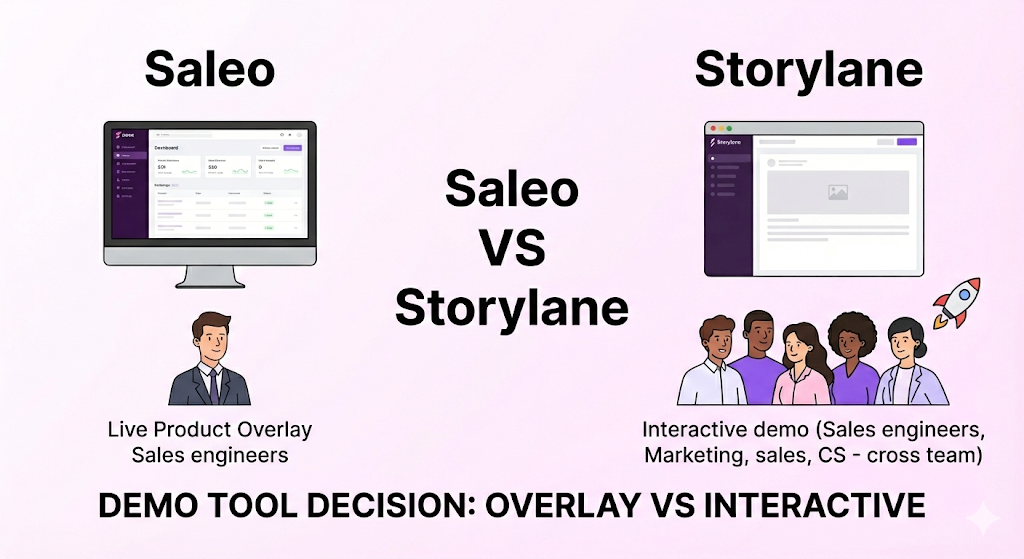When purchasing software solutions from a technology provider, you'd first research and evaluate the features. Next, you'd read reviews, compare pricing plans, and then come to a decision.
Is that all? Not quite.
According to Mckinsey's report, today's buyers are glued to their screens, tech-savvy, and in control of their time. Technology is changing the game for buyers and suppliers, from buyer enablement to hybrid models.
Curious about the latest trends and stages of B2B buying in 2024?
Let's uncover the ins and outs of the B2B decision-making process, the individuals involved, and the stages of buying.
What is a B2B Buying Process?
When businesses want to purchase goods or services from other businesses, they don't just walk into a store and pick up a product off the shelf as regular consumers do. Instead, the B2B (business-to-business) buying process refers to the series of steps that businesses go through when purchasing goods or services from other businesses.
B2B buying involves not one but multiple decision-makers who have to agree on everything before making a move.
Who is Involved in a B2B Purchase Process?
In a B2B purchase process, multiple individuals or departments within a business are involved in the decision-making process. This can include:
- Initiator: The department first identifies the need for a B2B product or service.
- Influencer: The department that provides input or recommendations during the decision-making process.
- Decision-maker: The group that makes the final decision on whether or not to purchase the product or service.
- Purchaser: The department responsible for executing the purchase and negotiating the contract terms.
- User: The department that will use the product or service once purchased.

What Does the B2B Buying Process Look Like?
The B2B buying process involves:
- Problem recognition
- Information search
- Evaluation of alternatives
- Purchase decision
- Purchase implementation and
- Post-purchase evaluation
Businesses recognize a need, research potential solutions, evaluate alternatives, make a final purchase decision based on their needs, negotiate terms, and evaluate supplier performance. The process is more complex than B2C (business-to-consumer) buying as it involves multiple decision-makers and longer sales cycles.

The 6 Main Stages of B2B Buying Process
The B2B buying process is a series of stages businesses go through when considering and ultimately making a purchase decision. These stages are as follows:
Stage 1: Problem Identification
This stage involves identifying a need or problem the business wants to address. The business may identify a problem through various means, such as internal analysis, customer feedback, or industry trends.
Stage 2: Solution Exploration
In this stage, the business will start exploring potential solutions. This involves researching different products or services to address their needs or problems. For example, the business may consult with industry experts, attend trade shows or conferences, or conduct online research to identify potential solutions.
Stage 3: Requirements Building
Businesses will begin to build requirements for the purchase in this stage. This involves defining the specific features or capabilities that the product or service must have to address their need or problem. The business may also establish a budget for the purchase.
Stage 4: Supplier Selection
Once the requirements have been defined, the business will begin evaluating potential suppliers. This involves reviewing supplier capabilities, assessing product or service offerings, and determining whether the supplier can meet the business's requirements. The business may also negotiate pricing and contract terms with the supplier.
Stage 5: Validation
The business may validate further to ensure the selected solution meets its requirements. This may involve testing the product or service, reviewing customer references, or conducting site visits to ensure the supplier can deliver on their promises.
Stage 6: Consensus Creation
The business must create consensus around the purchase decision. This involves ensuring that all stakeholders within the business are aligned and supportive of the purchase decision.
This may involve presenting the purchase decision to senior management or obtaining buy-in from other departments within the business. Once consensus has been reached, the purchase can be made.

What's The Difference Between B2B and B2C Buying Process?
B2B and B2C have different types of sales models catering to different target audiences. In addition, the buying process in B2B and B2C is quite different due to customer needs and purchasing behaviors.
The main differences between B2B and B2C buying processes are:
Decision-making
When making a B2B purchase decision, it's rarely a one-person show. A B2B decision-making process involves a group or committee of individuals assessing product quality or service potential to meet their business needs. However, in the world of B2C, things are a bit simpler. A single individual usually decides on a purchase based on their needs and preferences.
Sales Cycle
The B2B sales process is longer than in B2C as the B2B purchasing decisions involve more research, negotiation, and evaluation. Conversely, in B2C purchases, the sales cycle is generally shorter as purchasing decisions are more spontaneous and based on impulse buying.
Order Value
In B2B, the order value is usually higher as businesses make cost-intensive purchases to look after their workforce management and organizational needs. However, B2C order value is smaller as customers purchase products or services for their personal use.

The Impact of Technology on the B2B Buying Process
By 2025, Gartner predicts that a whopping 80% of B2B sales will go to the digital experiences. Technology has been changing the B2B buying process constantly. Here are a few aspects shaping it:
Buyer Enablement
Technology has ushered in a new era of "buyer enablement" – a term coined by Gartner – which empowers buyers by providing them access to crucial information. This newfound power enables them to make quicker and more informed purchasing decisions Over 65% of companies havethan ever before.
With technology at their fingertips, all you need is a click of a button to access information. Research shows that a substantial 27% of all information buyers require is obtained through online research.
Hybrid Models
Over 65% of companies have taken a fancy to the convenience of remote and digital interactions, sparking an interesting trend of hybrid roles. This game-changing approach has enabled traditional in-person sellers to amplify their sales game with cutting-edge technology.
Picture this - sellers using speech analytics to pick up on subtle verbal cues from B2B customers or analyzing video footage to clarify complex queries. Wholeheartedly embracing the hybrid model as the go-to approach has given customers the freedom to choose the hybrid or digital channels that best suit their buying journey.
More Efficient, Cost-Effective, and Time-Saving Process
Automation of the purchasing process is a game-changer, eliminating the need for human intervention and reducing time and cost expenditures. This is especially beneficial for tedious and error-prone tasks, where technology can help minimize mistakes.
With virtual meetings, face-to-face meetings with suppliers are almost redundant. Technology has allowed all interactions to occur remotely and instantaneously, making physical meetings unnecessary.
More Informed Buyers
The modern B2B landscape has evolved drastically. With a wealth of information at their fingertips, prospective customers now embark on independent research more than ever, resulting in heightened awareness of available options.
While this influx of information can improve the buying experience, it also poses a challenge for B2B businesses. With abundant choices available, capturing the attention of potential clients during critical decision-making moments is becoming increasingly difficult. In addition, the B2B arena is now more fiercely competitive than ever, leaving no room for complacency.

B2B Buying Process: The Key Trends of 2025
The B2B buying process is constantly evolving. Here are the key trends that will shape it in 2024
Limited Buyer Time
According to Gartner's Future of B2B Buying Journey Report, sales representatives only have approximately 5% of a customer's time available during a B2B buying journey. Surprisingly, 44% of millennials would rather not interact with sales reps in a B2B environment.
The combination of limited time with B2B buyers and the rapidly evolving buying landscape influenced by digital experiences encourages B2B sales teams to reassess their strategic priorities.
Streamlined Buying Process
A recent survey by Gartner revealed that a staggering 77% of respondents found the buying process highly complex and challenging. This difficulty is compounded in B2B buying groups, which often involve many decision-makers, ranging from six to ten individuals.
To complicate matters, these groups are armed with only a limited amount of information, around four to five key pieces, which they must use to navigate an ever-growing range of available options.
With the tech space evolving too, B2B buying processes are on their way to become simpler and more effective for potential buyers.
The Power of Useful Information in B2B Buying
Customers who felt that the information provided by their suppliers was useful in helping them navigate their purchasing process were significantly more likely to have a positive buying experience.
In addition, those who perceived the information helpful were 2.8 times more likely to find the purchasing process easy, which could lead to increased customer satisfaction and loyalty.
These customers were also three times more likely to make a larger purchase and experience less regret about their B2B buying decision. This highlights the importance of providing customers with relevant and valuable information throughout the buying journey, as it can significantly impact their overall satisfaction and likelihood of making repeat purchases.
Demand for Demos or Free Trials
TrustRadius reports that business buyers highly prefer self-service options, with 100% expressing a strong preference for such options. Additionally, 70% of B2B buyers have stated that tech B2B vendors offering demos or free trials can increase their likelihood of purchasing.
It's important to note that providing demos or free trials allows potential customers to experience the product or service firsthand, increasing their chances of purchasing.
Barriers to Making a Purchase
Most of the potential business buyers surveyed expressed a desire for some form of product demonstration or trial before making an informed purchasing decision. Specifically, 64% preferred a free trial, 43% preferred a self-guided demo, and 40% preferred an online product tour.
However, 40% of buyers identified the requirement to contact the sales team for a demo or trial as one of the biggest barriers to making a purchase. This highlights the importance of providing accessible and easy-to-use product demos or free trials to potential buyers.
If you aim to succeed in the B2B purchasing landscape, you should prioritize buyer enablement, which involves offering customers tailored information that supports them in accomplishing their purchasing tasks. With sales reps having less of a buyer's time and most buyers finding the B2B buying process complex, it's no wonder customers prefer demos and free trials.
The Modern Solution for B2B Buyer Enablement in 2025
With Storylane's no-code platform, you can build interactive product demos in just minutes.
First, embed guided product tours on your website, landing pages, blog posts, and social media or share in email campaigns. Then, replicate your product in custom demos tailored to your personas and geared towards improving conversions.
And with our world-class no-code editor, you can personalize anything in your demos. Finally, for customer success, create a visual library of interactive product walkthroughs to onboard your customers.
Let your potential customers experience the value your product can bring. Book a free demo to try Storylane's interactive product demos today!

.svg)
.svg)





.webp)




























.svg)

.webp)